Fluorescence Hyperspectral Imaging for Early Diagnosis of Heat-Stressed Ginseng Plants
Abstract
1. Introduction
2. Materials and Methods
2.1. Experimental Design
2.2. Fluorescence Hyperspectral Imaging System
2.3. Image Acquisition and Correction
2.4. Data Extraction and Analysis
2.4.1. Spectral Extraction and Preprocessing
2.4.2. Analysis of Variance and Waveband Selection
2.4.3. Ratio Image for the Differentiation and Visualization of Heat-Stressed Plants
2.4.4. Reference Measurements SPAD-502
2.4.5. Model Development
3. Results
3.1. Spectral Profile of Ginseng Plants
3.2. SPAD Measurements Results
3.3. ANOVA Analysis
Band Ratio Images for the Visualization of Stressed Plants
3.4. PLSR Model Performance
4. Discussion
4.1. Spectral Analysis
4.2. Reference Measurement Analysis
4.3. ANOVA Results Analysis
4.4. PLSR Results Analysis
5. Conclusions
Author Contributions
Funding
Institutional Review Board Statement
Informed Consent Statement
Data Availability Statement
Conflicts of Interest
References
- Park, J.E.; Kim, H.; Kim, J.; Choi, S.J.; Ham, J.; Nho, C.W.; Yoo, G. A Comparative Study of Ginseng Berry Production in a Vertical Farm and an Open Field. Ind. Crops Prod. 2019, 140, 111612. [Google Scholar] [CrossRef]
- Park, H.J.; Kim, D.H.; Park, S.J.; Kim, J.M.; Ryu, J.H. Ginseng in Traditional Herbal Prescriptions. J. Ginseng Res. 2012, 36, 225–241. [Google Scholar] [CrossRef] [PubMed]
- Karmalkar, A.V.; Bradley, R.S. Consequences of Global Warming of 1.5 °c and 2 °c for Regional Temperature and Precipitation Changes in the Contiguous United States. PLoS ONE 2017, 12, 1–17. [Google Scholar] [CrossRef] [PubMed]
- Mo, H.S.; Jang, I.B.; Yu, J.; Park, H.W.; Park, K.C. Effects of Enhanced Light Transmission Rate During the Early Growth Stage on Plant Growth, Photosynthetic Ability and Disease Incidence of Above Ground in Panax Ginseng. Korean J. Med. Crop Sci. 2015, 23, 284–291. [Google Scholar] [CrossRef]
- Kim, S.W.; Gupta, R.; Min, C.W.; Lee, S.H.; Cheon, Y.E.; Meng, Q.F.; Jang, J.W.; Hong, C.E.; Lee, J.Y.; Jo, I.H.; et al. Label-Free Quantitative Proteomic Analysis of Panax Ginseng Leaves upon Exposure to Heat Stress. J. Ginseng Res. 2019, 43, 143–153. [Google Scholar] [CrossRef]
- Hong, J.; Geem, K.R.; Kim, J.; Jo, I.H.; Yang, T.J.; Shim, D.; Ryu, H. Prolonged Exposure to High Temperature Inhibits Shoot Primary and Root Secondary Growth in Panax Ginseng. Int. J. Mol. Sci. 2022, 23, 11647. [Google Scholar] [CrossRef]
- Hwang, C.R.; Lee, S.H.; Jang, G.Y.; Hwang, I.G.; Kim, H.Y.; Woo, K.S.; Lee, J.; Jeong, H.S. Changes in Ginsenoside Compositions and Antioxidant Activities of Hydroponic-Cultured Ginseng Roots and Leaves with Heating Temperature. J. Ginseng Res. 2014, 38, 180–186. [Google Scholar] [CrossRef]
- Lee, J.S.; Lee, K.H.; Lee, S.S.; Kim, E.S.; Ahn, I.O.; In, J.G. Morphological Characteristics of Ginseng Leaves in High-Temperature Injury Resistant and Susceptible Lines of Panax Ginseng Meyer. J. Ginseng Res. 2011, 35, 449–456. [Google Scholar] [CrossRef]
- Jayakodi, M.; Lee, S.C.; Yang, T.J. Comparative Transcriptome Analysis of Heat Stress Responsiveness between Two Contrasting Ginseng Cultivars. J. Ginseng Res. 2019, 43, 572–579. [Google Scholar] [CrossRef]
- Mittler, R. Abiotic Stress, the Field Environment and Stress Combination. Trends Plant Sci. 2006, 11, 15–19. [Google Scholar] [CrossRef]
- Persons, S.W.; Davis, J. Growing Ginseng Under Artificial Shade. Available online: https://www.wildgrown.com/index.php/growing-ginseng/120-growing-ginseng-under-artificial-shade (accessed on 10 November 2022).
- Jia, L.; Zhao, Y. Current Evaluation of the Millennium Phytomedicine- Ginseng (I): Etymology, Pharmacognosy, Phytochemistry, Market and Regulations. Curr. Med. Chem. 2009, 16, 2475–2484. [Google Scholar] [CrossRef] [PubMed]
- Kim, Y.J.; Nguyen, T.K.L.; Oh, M.M. Growth and Ginsenosides Content of Ginseng Sprouts According to Led-Based Light Quality Changes. Agronomy 2020, 10, 1979. [Google Scholar] [CrossRef]
- Kim, Y.J.; Zhang, D.; Yang, D.C. Biosynthesis and Biotechnological Production of Ginsenosides. Biotechnol. Adv. 2015, 33, 717–735. [Google Scholar] [CrossRef] [PubMed]
- Kolhar, S.; Jagtap, J. Plant Trait Estimation and Classification Studies in Plant Phenotyping Using Machine Vision – A Review. Inf. Process. Agric. 2021. [Google Scholar] [CrossRef]
- Cotrozzi, L.; Couture, J.J. Hyperspectral Assessment of Plant Responses to Multi-Stress Environments: Prospects for Managing Protected Agrosystems. Plants People Planet 2020, 2, 244–258. [Google Scholar] [CrossRef]
- Fahrentrapp, J.; Ria, F.; Geilhausen, M.; Panassiti, B. Detection of Gray Mold Leaf Infections Prior to Visual Symptom Appearance Using a Five-Band Multispectral Sensor. Front. Plant Sci. 2019, 10, 1–14. [Google Scholar] [CrossRef]
- Gu, Q.; Sheng, L.; Zhang, T.; Lu, Y.; Zhang, Z.; Zheng, K.; Hu, H.; Zhou, H. Early Detection of Tomato Spotted Wilt Virus Infection in Tobacco Using the Hyperspectral Imaging Technique and Machine Learning Algorithms. Comput. Electron. Agric. 2019, 167, 105066. [Google Scholar] [CrossRef]
- Asaari, M.S.M.; Mertens, S.; Dhondt, S.; Inzé, D.; Wuyts, N.; Scheunders, P. Analysis of Hyperspectral Images for Detection of Drought Stress and Recovery in Maize Plants in a High-Throughput Phenotyping Platform. Comput. Electron. Agric. 2019, 162, 749–758. [Google Scholar] [CrossRef]
- Sánchez, M.T.; Entrenas, J.A.; Torres, I.; Vega, M.; Pérez-Marín, D. Monitoring Texture and Other Quality Parameters in Spinach Plants Using NIR Spectroscopy. Comput. Electron. Agric. 2018, 155, 446–452. [Google Scholar] [CrossRef]
- Kasampalis, D.S.; Tsouvaltzis, P.; Ntouros, K.; Gertsis, A.; Gitas, I.; Siomos, A.S. The Use of Digital Imaging, Chlorophyll Fluorescence and Vis/NIR Spectroscopy in Assessing the Ripening Stage and Freshness Status of Bell Pepper Fruit. Comput. Electron. Agric. 2021, 187, 106265. [Google Scholar] [CrossRef]
- Swarup, A.; Lee, W.S.; Peres, N.; Fraisse, C. Strawberry Plant Wetness Detection Using Color and Thermal Imaging. J. Biosyst. Eng. 2020, 45, 409–421. [Google Scholar] [CrossRef]
- Raza, S.E.A.; Prince, G.; Clarkson, J.P.; Rajpoot, N.M. Automatic Detection of Diseased Tomato Plants Using Thermal and Stereo Visible Light Images. PLoS ONE 2015, 10, e0123262. [Google Scholar] [CrossRef] [PubMed]
- Zhuang, S.; Wang, P.; Jiang, B.; Li, M.; Gong, Z. Early Detection of Water Stress in Maize Based on Digital Images. Comput. Electron. Agric. 2017, 140, 461–468. [Google Scholar] [CrossRef]
- Zhou, S.; Mou, H.; Zhou, J.; Zhou, J.; Ye, H.; Nguyen, H.T. Development of an Automated Plant Phenotyping System for Evaluation of Salt Tolerance in Soybean. Comput. Electron. Agric. 2021, 182, 106001. [Google Scholar] [CrossRef]
- Putra, B.T.W.; Amirudin, R.; Marhaenanto, B. The Evaluation of Deep Learning Using Convolutional Neural Network (CNN) Approach for Identifying Arabica and Robusta Coffee Plants. J. Biosyst. Eng. 2022, 47, 118–129. [Google Scholar] [CrossRef]
- Mishra, P.; Feller, T.; Schmuck, M.; Nicol, A.; Nordon, A. Early Detection of Drought Stress in Arabidopsis Thaliana Utilsing a Portable Hyperspectral Imaging Setup. In Proceedings of the 2019 10th Workshop on Hyperspectral Imaging and Signal Processing: Evolution in Remote Sensing (WHISPERS), Amsterdam, The Netherlands, 24–26 September 2019; pp. 1–5. [Google Scholar] [CrossRef]
- Mishra, P.; Feller, T.; Schmuck, M.; Nicol, A.; Nordon, A. Early Detection of Drought Stress in Arabidopsis Thaliana Utilsing a Portable Hyperspectral Imaging Setup WestCHEM; Department of Pure and Applied Chemistry and Centre for Process Analytics and Control Technology, University of Strathclyde: Glasgow, UK, 2019; pp. 2–6. [Google Scholar]
- Wang, D.; Vinson, R.; Holmes, M.; Seibel, G.; Bechar, A.; Nof, S.; Tao, Y. Early Detection of Tomato Spotted Wilt Virus by Hyperspectral Imaging and Outlier Removal Auxiliary Classifier Generative Adversarial Nets (OR-AC-GAN). Sci. Rep. 2019, 9, 4377. [Google Scholar] [CrossRef]
- Mo, C.; Kim, M.S.; Kim, G.; Cheong, E.J.; Yang, J.; Lim, J. Detecting Drought Stress in Soybean Plants Using Hyperspectral Fluorescence Imaging. J. Biosyst. Eng. 2015, 40, 335–344. [Google Scholar] [CrossRef]
- Rajendran, D.K.; Park, E.; Nagendran, R.; Hung, N.B.; Cho, B.K.; Kim, K.H.; Lee, Y.H. Visual Analysis for Detection and Quantification of Pseudomonas Cichorii Disease Severity in Tomato Plants. Plant Pathol. J. 2016, 32, 300–310. [Google Scholar] [CrossRef]
- Bauriegel, E.; Herppich, W.B. Hyperspectral and Chlorophyll Fluorescence Imaging for Early Detection of Plant Diseases, with Special Reference to Fusarium Spec. Infections on Wheat. Agriculture 2014, 4, 32–57. [Google Scholar] [CrossRef]
- Montero, R.; Pérez-Bueno, M.L.; Barón, M.; Florez-Sarasa, I.; Tohge, T.; Fernie, A.R.; El aou ouad, H.; Flexas, J.; Bota, J. Alterations in Primary and Secondary Metabolism in Vitis Vinifera ‘Malvasía de Banyalbufar’ upon Infection with Grapevine Leafroll-Associated Virus 3. Physiol. Plant. 2016, 157, 442–452. [Google Scholar] [CrossRef]
- Mazur, R.; Sadowska, M.; Kowalewska, Ł.; Abratowska, A.; Kalaji, H.M.; Mostowska, A.; Garstka, M.; Krasnodebska-Ostrega, B. Overlapping Toxic Effect of Long Term Thallium Exposure on White Mustard (Sinapis Alba L.) Photosynthetic Activity. BMC Plant Biol. 2016, 16, 89–101. [Google Scholar] [CrossRef] [PubMed]
- Wang, N.; Clevers, J.G.P.W.; Wieneke, S.; Bartholomeus, H.; Kooistra, L. Potential of UAV-Based Sun-Induced Chlorophyll Fluorescence to Detect Water Stress in Sugar Beet. Agric. For. Meteorol. 2022, 323, 109033. [Google Scholar] [CrossRef]
- Zarco-Tejada, P.J.; Pushnik, J.C.; Dobrowski, S.; Ustin, S.L. Steady-State Chlorophyll a Fluorescence Detection from Canopy Derivative Reflectance and Double-Peak Red-Edge Effects. Remote Sens. Environ. 2003, 84, 283–294. [Google Scholar] [CrossRef]
- Hernández-Clemente, R.; North, P.R.J.; Hornero, A.; Zarco-Tejada, P.J. Assessing the Effects of Forest Health on Sun-Induced Chlorophyll Fluorescence Using the FluorFLIGHT 3-D Radiative Transfer Model to Account for Forest Structure. Remote Sens. Environ. 2017, 193, 165–179. [Google Scholar] [CrossRef]
- Dong, X.; Kim, W.Y.; Lee, K.H. Drone-Based Three-Dimensional Photogrammetry and Concave Hull by Slices Algorithm for Apple Tree Volume Mapping. J. Biosyst. Eng. 2021, 46, 474–484. [Google Scholar] [CrossRef]
- Saleem, M.; Atta, B.M.; Ali, Z.; Bilal, M. Laser-Induced Fluorescence Spectroscopy for Early Disease Detection in Grapefruit Plants. Photochem. Photobiol. Sci. 2020, 19, 713–721. [Google Scholar] [CrossRef]
- Mahlein, A.-K. Present and Future Trends in Plant Disease Detection. Plant Dis. 2016, 100, 89–101. [Google Scholar] [CrossRef]
- Bodria, L.; Fiala, M.; Oberti, R.; Naldi, E. Chlorophyll Fluorescence Sensing for Early Detection of Crop’s Diseases Symptoms. In Proceedings of the 2002 ASAE Annual International Meeting, Chicago, IL, USA, 28–31 July 2002; pp. 1–15. [Google Scholar]
- Kuckenberg, J.; Tartachnyk, I.; Noga, G. Temporal and Spatial Changes of Chlorophyll Fluorescence as a Basis for Early and Precise Detection of Leaf Rust and Powdery Mildew Infections in Wheat Leaves. Precis. Agric. 2009, 10, 34–44. [Google Scholar] [CrossRef]
- Treibitz, T.; Neal, B.P.; Kline, D.I.; Beijbom, O.; Roberts, P.L.D.; Mitchell, B.G.; Kriegman, D. Wide Field-of-View Fluorescence Imaging of Coral Reefs. Sci. Rep. 2015, 5, 7694. [Google Scholar] [CrossRef]
- Norikane, J.H.; Kurata, K. Water Stress Detection By Monitoring Fluorescence of Plants under Ambient Light. Trans. ASAE 2001, 44, 1915–1922. [Google Scholar] [CrossRef]
- Faqeerzada, M.A.; Lohumi, S.; Kim, G.; Joshi, R.; Lee, H.; Kim, M.S.; Cho, B.K. Hyperspectral Shortwave Infrared Image Analysis for Detection of Adulterants in Almond Powder with One-Class Classification Method. Sensors 2020, 20, 5855. [Google Scholar] [CrossRef] [PubMed]
- Rahman, A.; Faqeerzada, M.A.; Cho, B.K. Hyperspectral Imaging for Predicting the Allicin and Soluble Solid Content of Garlic with Variable Selection Algorithms and Chemometric Models. J. Sci. Food Agric. 2018, 98, 4715–4725. [Google Scholar] [CrossRef] [PubMed]
- Park, E.; Kim, Y.S.; Omari, M.K.; Suh, H.K.; Faqeerzada, M.A.; Kim, M.S.; Baek, I.; Cho, B.K. High-Throughput Phenotyping Approach for the Evaluation of Heat Stress in Korean Ginseng (Panax Ginseng Meyer) Using a Hyperspectral Reflectance Image. Sensors 2021, 21, 5634. [Google Scholar] [CrossRef] [PubMed]
- Faqeerzada, M.A.; Perez, M.; Lohumi, S.; Lee, H.; Kim, G.; Wakholi, C.; Joshi, R.; Cho, B.K. Online Application of a Hyperspectral Imaging System for the Sorting of Adulterated Almonds. Appl. Sci. 2020, 10, 6569. [Google Scholar] [CrossRef]
- Rahman, A.; Faqeerzada, M.A.; Joshi, R.; Lohumi, S.; Kandpal, L.M.; Lee, H.; Mo, C.; Kim, M.S.; Cho, B.K. Quality Analysis of Stored Bell Peppers Using Near-Infrared Hyperspectral Imaging. Trans. ASABE 2018, 61, 1199–1207. [Google Scholar] [CrossRef]
- Rinnan, Å.; van den Berg, F.; Engelsen, S.B. Review of the Most Common Pre-Processing Techniques for near-Infrared Spectra. TrAC—Trends Anal. Chem. 2009, 28, 1201–1222. [Google Scholar] [CrossRef]
- Yuan, Z.; Cao, Q.; Zhang, K.; Ata-Ul-Karim, S.T.; Tan, Y.; Zhu, Y.; Cao, W.; Liu, X. Optimal Leaf Positions for SPAD Meter Measurement in Rice. Front. Plant Sci. 2016, 7, 1–10. [Google Scholar] [CrossRef]
- Uddling, J.; Gelang-Alfredsson, J.; Piikki, K.; Pleijel, H. Evaluating the Relationship between Leaf Chlorophyll Concentration and SPAD-502 Chlorophyll Meter Readings. Photosynth. Res. 2007, 91, 37–46. [Google Scholar] [CrossRef]
- Borhan, M.S.; Panigrahi, S.; Satter, M.A.; Gu, H. Evaluation of Computer Imaging Technique for Predicting the SPAD Readings in Potato Leaves. Inf. Process. Agric. 2017, 4, 275–282. [Google Scholar] [CrossRef]
- Ling, Q.; Huang, W.; Jarvis, P. Use of a SPAD-502 Meter to Measure Leaf Chlorophyll Concentration in Arabidopsis Thaliana. Photosynth. Res. 2011, 107, 209–214. [Google Scholar] [CrossRef]
- Xiong, D.; Chen, J.; Yu, T.; Gao, W.; Ling, X.; Li, Y.; Peng, S.; Huang, J. SPAD-Based Leaf Nitrogen Estimation Is Impacted by Environmental Factors and Crop Leaf Characteristics. Sci. Rep. 2015, 5, 13389. [Google Scholar] [CrossRef] [PubMed]
- Markwell, J.; Osterman, J.C.; Mitchell, J.L. Calibration of the Minolta SPAD-502 Leaf Chlorophyll Meter. Photosynth. Res. 1995, 46, 467–472. [Google Scholar] [CrossRef] [PubMed]
- Rahman, A.; Kandpal, L.M.; Lohumi, S.; Kim, M.S.; Lee, H.; Mo, C.; Cho, B.K. Nondestructive Estimation of Moisture Content, PH and Soluble Solid Contents in Intact Tomatoes Using Hyperspectral Imaging. Appl. Sci. 2017, 7, 109. [Google Scholar] [CrossRef]
- Lohumi, S.; Lee, S.; Cho, B.K. Optimal Variable Selection for Fourier Transform Infrared Spectroscopic Analysis of Starch-Adulterated Garlic Powder. Sensors Actuators B Chem. 2015, 216, 622–628. [Google Scholar] [CrossRef]
- Faqeerzada, M.; Rahman, A.; Kim, G.; Park, E.; Joshi, R.; Lohumi, S.; Cho, B.-K. Prediction of Moisture Contents in Green Peppers Using Hyperspectral Imaging Based on a Polarized Lighting System. Korean J. Agric. Sci. 2020, 47, 995–1010. [Google Scholar]
- Tian, Y.; Xie, L.; Wu, M.; Yang, B.; Ishimwe, C.; Ye, D.; Weng, H. Multicolor Fluorescence Imaging for the Early Detection of Salt Stress in Arabidopsis. Agronomy 2021, 11, 2577. [Google Scholar] [CrossRef]
- Tan, C.; Wang, J.; Wu, T.; Qin, X.; Li, M. Determination of Nicotine in Tobacco Samples by Near-Infrared Spectroscopy and Boosting Partial Least Squares. Vib. Spectrosc. 2010, 54, 35–41. [Google Scholar] [CrossRef]
- Tunny, S.S.; Amanah, H.Z.; Faqeerzada, M.A.; Wakholi, C.; Kim, M.S.; Baek, I.; Cho, B.K. Multispectral Wavebands Selection for the Detection of Potential Foreign Materials in Fresh-Cut Vegetables. Sensors 2022, 22, 1775. [Google Scholar] [CrossRef]
- Jin, J.; Wang, Q. Evaluation of Informative Bands Used in Different PLS Regressions for Estimating Leaf Biochemical Contents from Hyperspectral Reflectance. Remote Sens. 2019, 11, 197. [Google Scholar] [CrossRef]
- Draper, N.R.; Smith, H. Applied Regression Analysis; John Wiley & Sons: Hoboken, NJ, USA, 1998; pp. 1–716. [Google Scholar]
- Xie, C.; Shao, Y.; Li, X.; He, Y. Detection of Early Blight and Late Blight Diseases on Tomato Leaves Using Hyperspectral Imaging. Sci. Rep. 2015, 5, 16564. [Google Scholar] [CrossRef]
- Anderson, B.; Buah-Bassuah, P.K.; Tetteh, J.P. Using Violet Laser-Induced Chlorophyll Fluorescence Emission Spectra for Crop Yield Assessment of Cowpea (Vigna Unguiculata (L) Walp) Varieties. Meas. Sci. Technol. 2004, 15, 1255–1265. [Google Scholar] [CrossRef]
- Limantara, L.; Dettling, M.; Indrawati, R.; Indriatmoko; Brotosudarmo, T.H.P. Analysis on the Chlorophyll Content of Commercial Green Leafy Vegetables. Procedia Chem. 2015, 14, 225–231. [Google Scholar] [CrossRef]
- Nauš, J.; Prokopová, J.; Řebíček, J.; Špundová, M. SPAD Chlorophyll Meter Reading Can Be Pronouncedly Affected by Chloroplast Movement. Photosynth. Res. 2010, 105, 265–271. [Google Scholar] [CrossRef] [PubMed]
- Wassie, M.; Zhang, W.; Zhang, Q.; Ji, K.; Chen, L. Effect of Heat Stress on Growth and Physiological Traits of Alfalfa (Medicago Sativa l.) and a Comprehensive Evaluation for Heat Tolerance. Agronomy 2019, 9, 597. [Google Scholar] [CrossRef]
- Hussain, H.A.; Men, S.; Hussain, S.; Chen, Y.; Ali, S.; Zhang, S.; Zhang, K.; Li, Y.; Xu, Q.; Liao, C.; et al. Interactive Effects of Drought and Heat Stresses on Morpho-Physiological Attributes, Yield, Nutrient Uptake and Oxidative Status in Maize Hybrids. Sci. Rep. 2019, 9, 1–12. [Google Scholar] [CrossRef]
- Keck, T.; Preusker, R.; Fischer, J. Estimating Chlorophyll-a Absorption with the Total Algae Peak Integration Retrieval TAPIR Considering Chlorophyll-a Fluorescence from Hyperspectral Top of the Atmosphere Signals in Optically Complex Waters. Preprints 2018, 2018020097. [Google Scholar] [CrossRef]
- Zhang, J.; Sun, H.; Gao, D.; Qiao, L.; Liu, N.; Li, M.; Zhang, Y. Detection of Canopy Chlorophyll Content of Corn Based on Continuous Wavelet Transform Analysis. Remote Sens. 2020, 12, 2741. [Google Scholar] [CrossRef]
- Yu, K.Q.; Zhao, Y.R.; Li, X.L.; Shao, Y.N.; Liu, F.; He, Y. Hyperspectral Imaging for Mapping of Total Nitrogen Spatial Distribution in Pepper Plant. PLoS ONE 2014, 9, e0134071. [Google Scholar] [CrossRef]
- Wu, Q.; Zhu, D.; Wang, C.; Ma, Z.; Wang, J. Diagnosis of Freezing Stress in Wheat Seedlings Using Hyperspectral Imaging. Biosyst. Eng. 2012, 112, 253–260. [Google Scholar] [CrossRef]
- Divyanth, L.G.; Chakraborty, S.; Li, B.; Weindorf, D.C.; Deb, P.; Gem, C.J. Non-Destructive Prediction of Nicotine Content in Tobacco Using Hyperspectral Image–Derived Spectra and Machine Learning. J. Biosyst. Eng. 2022, 47, 106–117. [Google Scholar] [CrossRef]
- Bandopadhyay, S.; Rastogi, A. Review of Top-of-Canopy Sun-Induced Fluorescence (SIF) Studies from Ground, UAV, Airborne to Spaceborne Observations. Sensors 2020, 20, 1144. [Google Scholar] [CrossRef] [PubMed]
- Legendre, R.; Basinger, N.T.; van Iersel, M.W. Low-Cost Chlorophyll Fluorescence Imaging for Stress Detection. Sensors 2021, 21, 2055. [Google Scholar] [CrossRef] [PubMed]
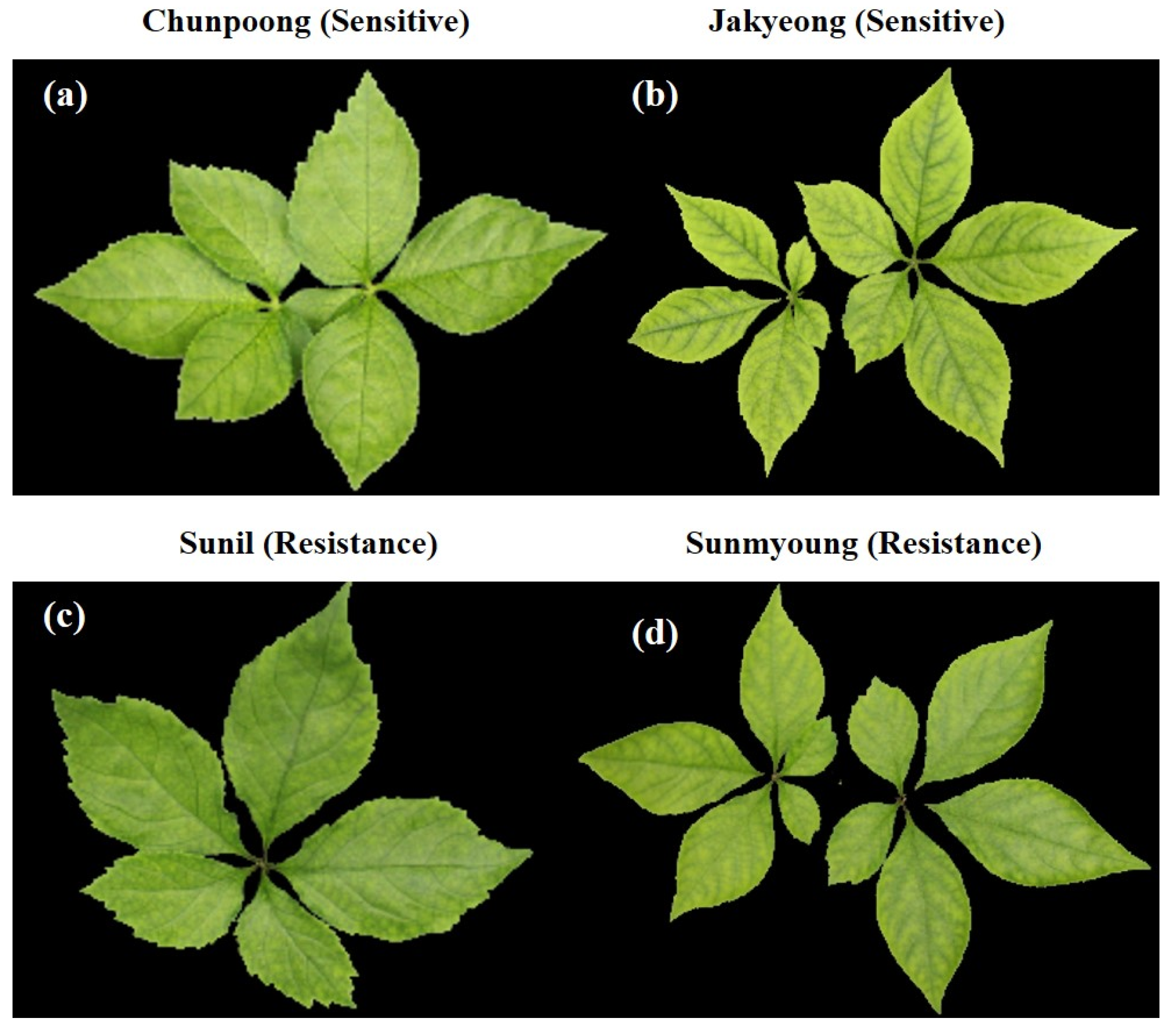

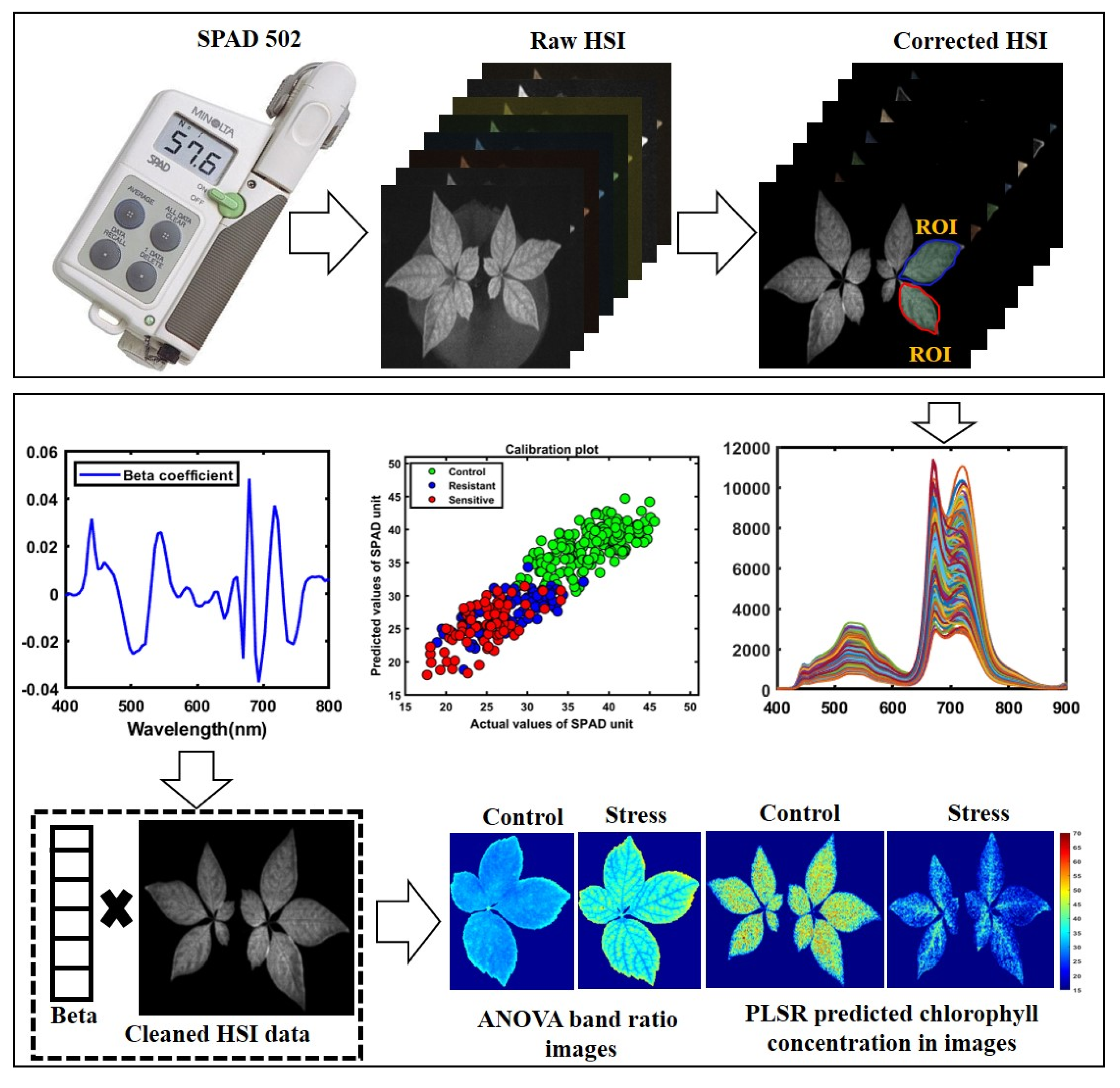
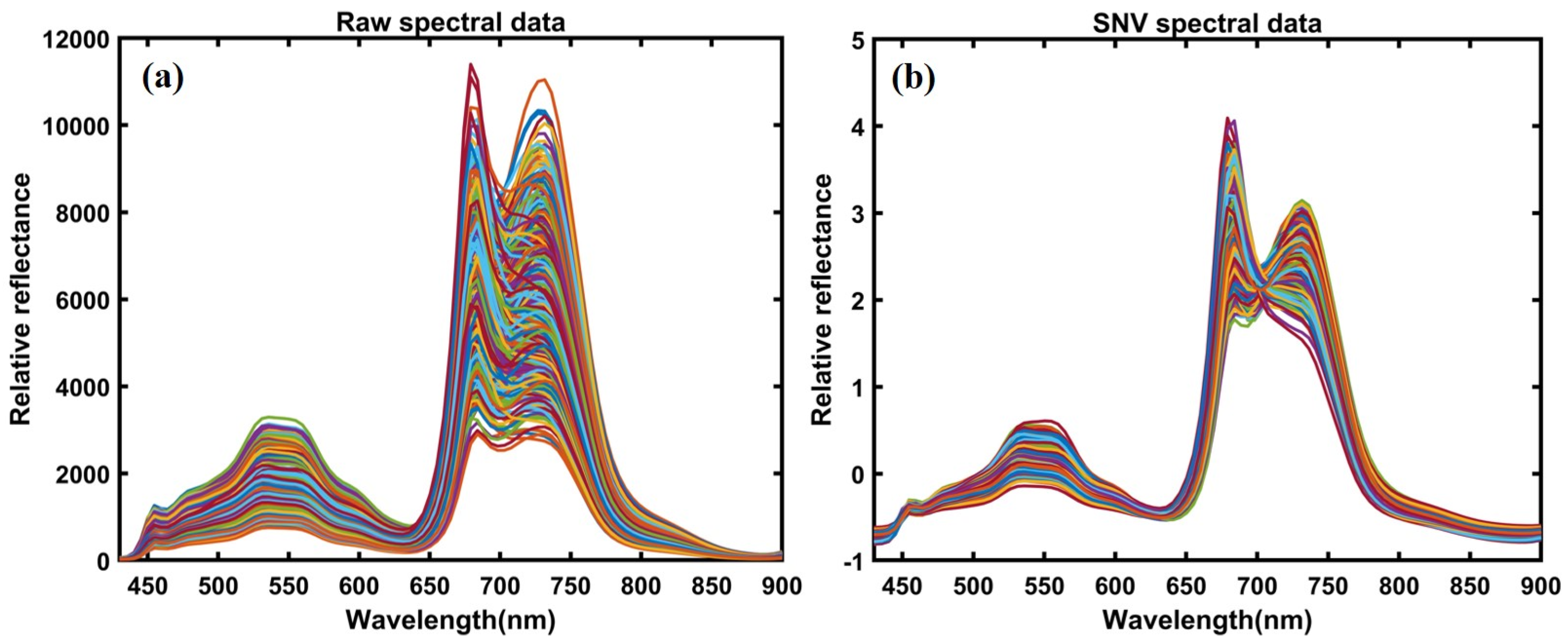
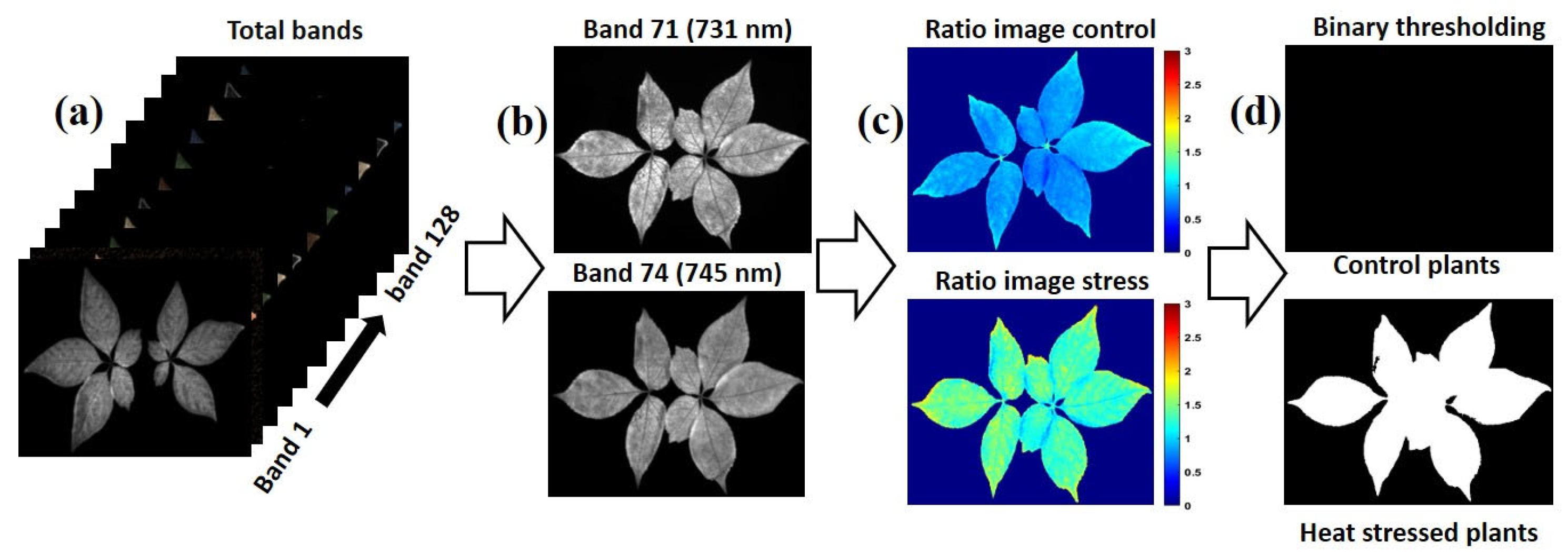

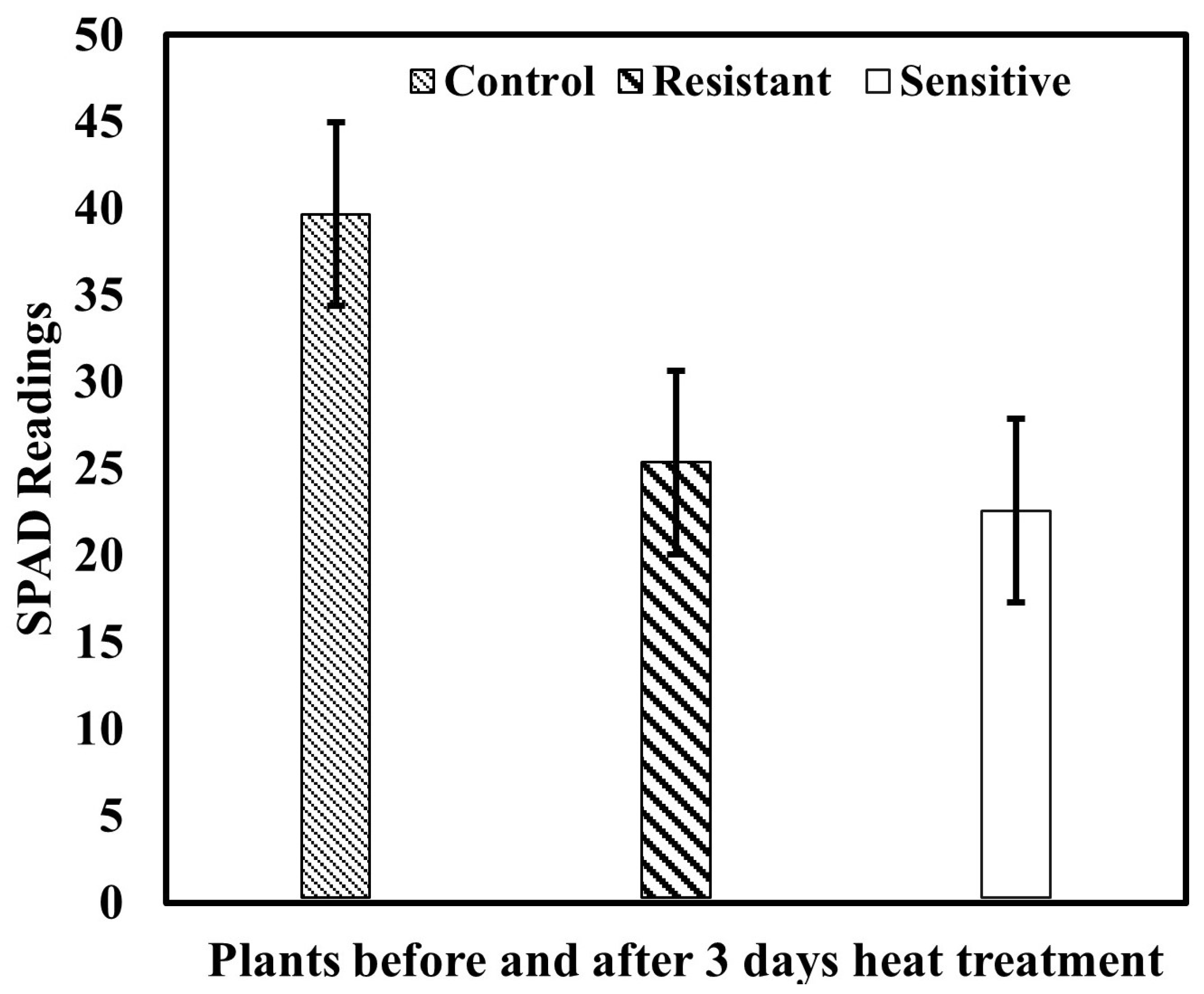
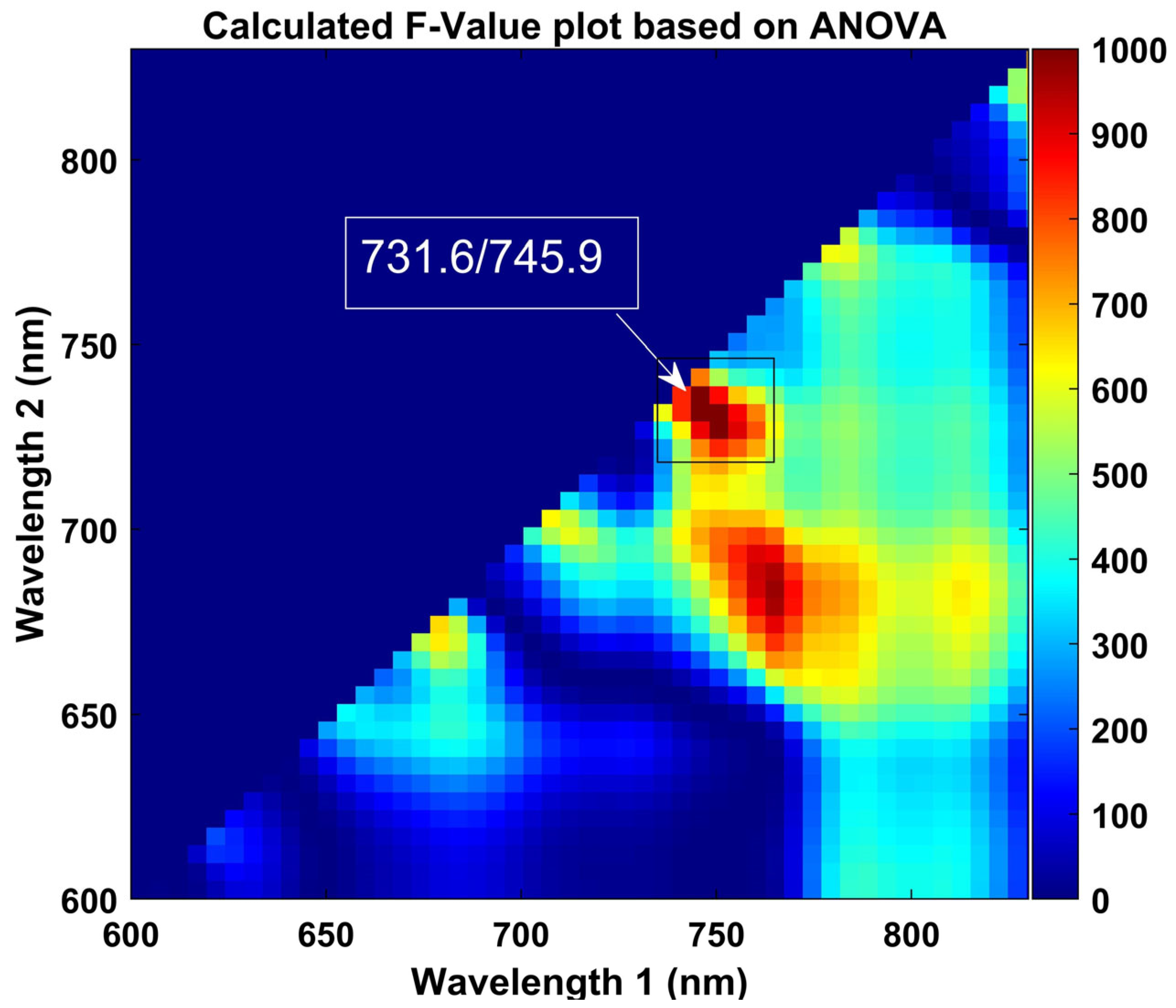
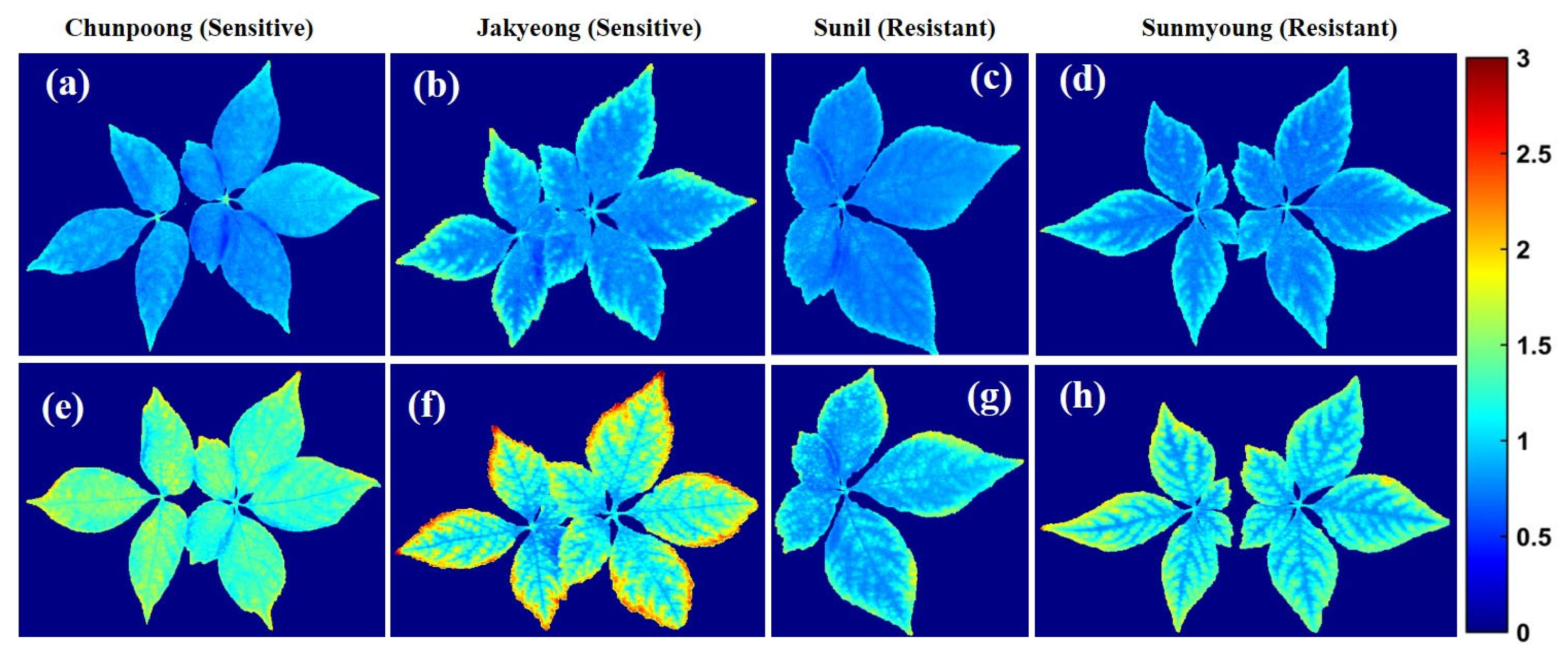
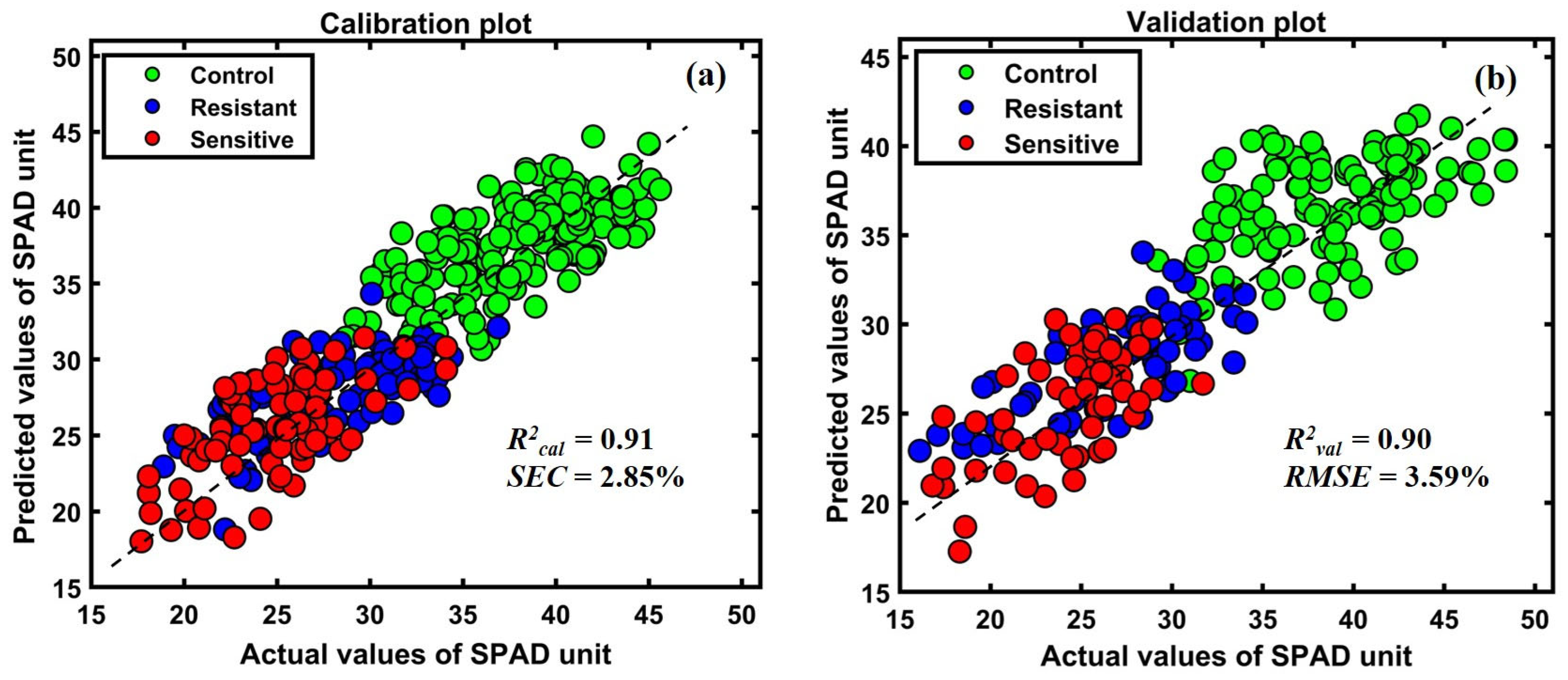
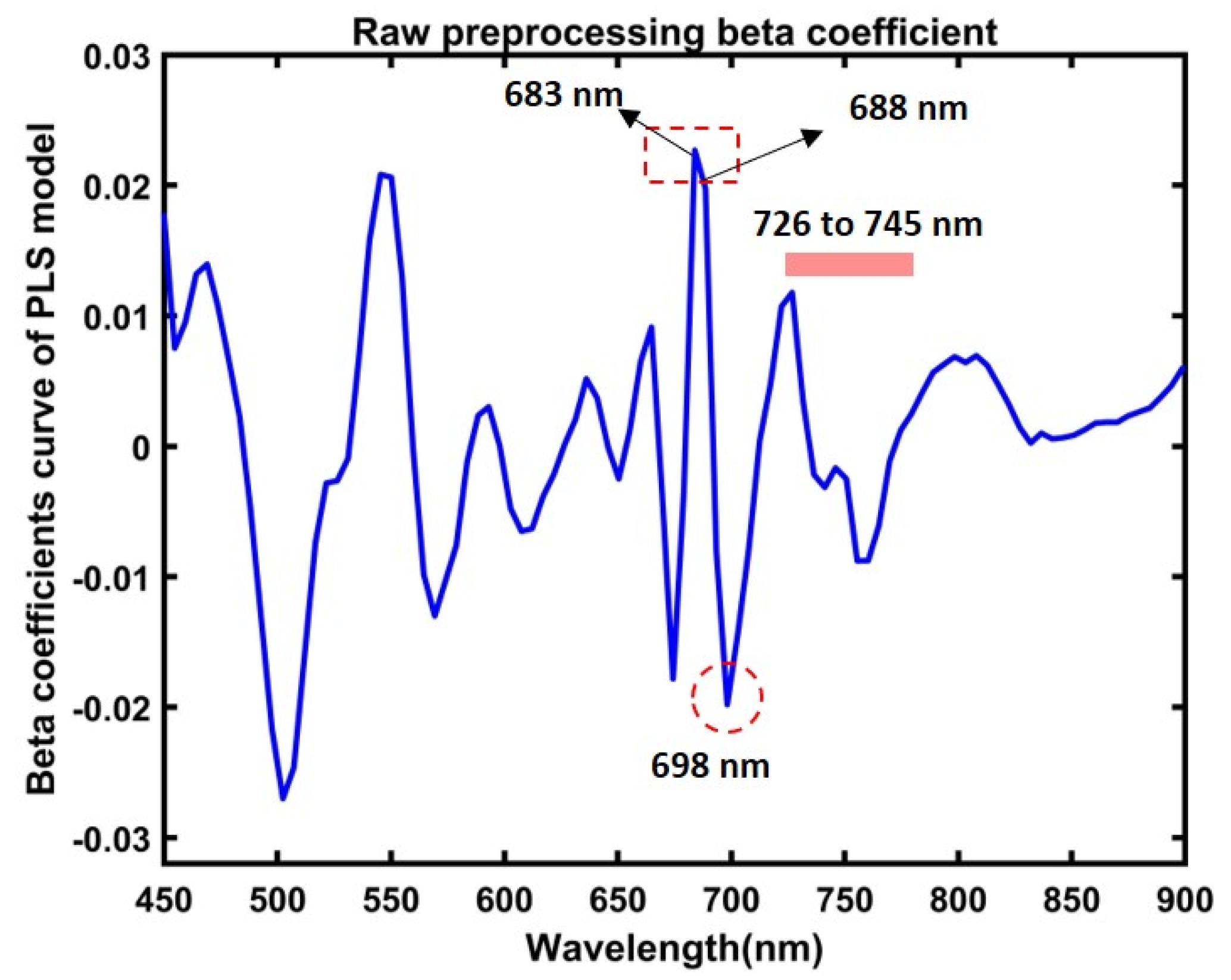
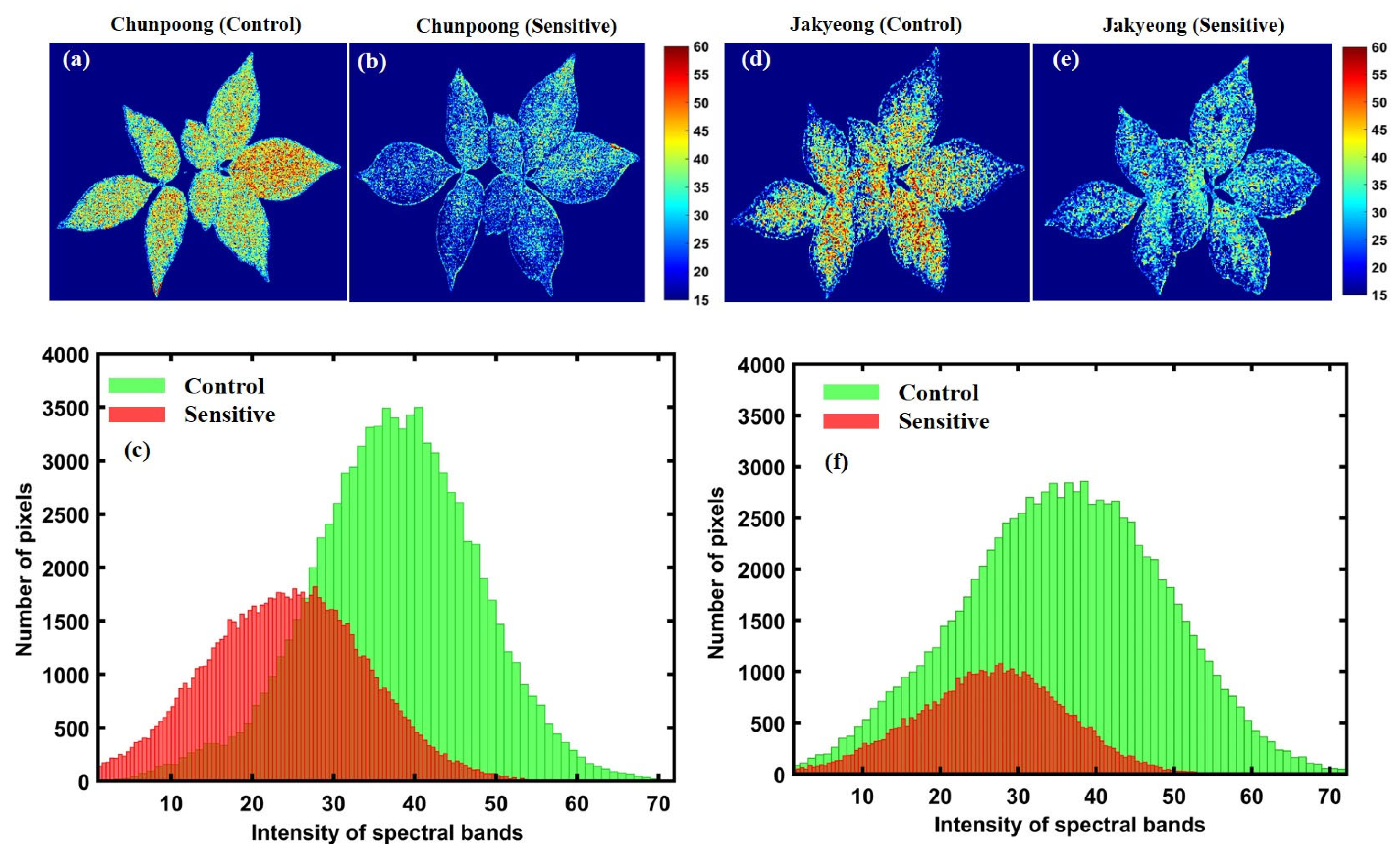
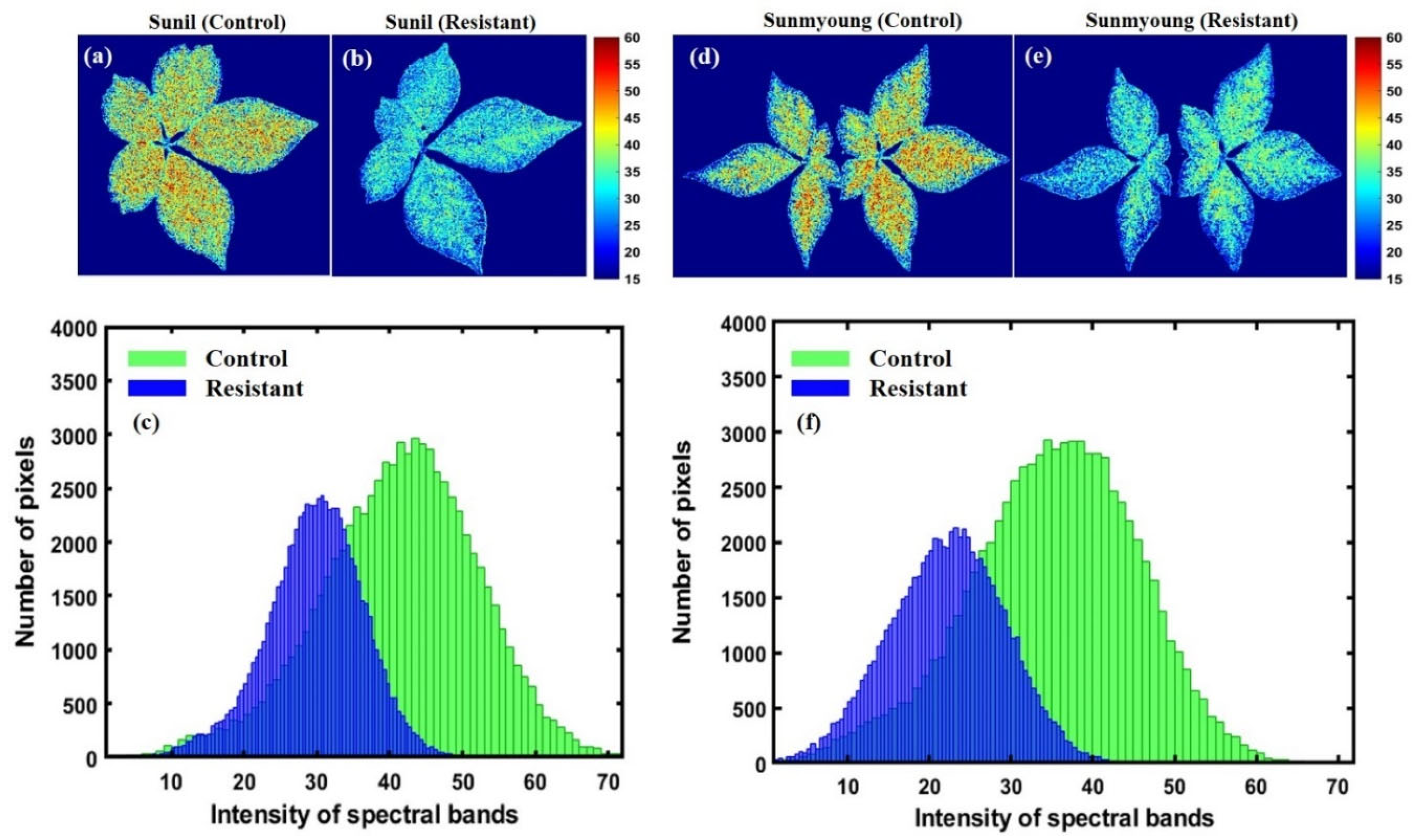
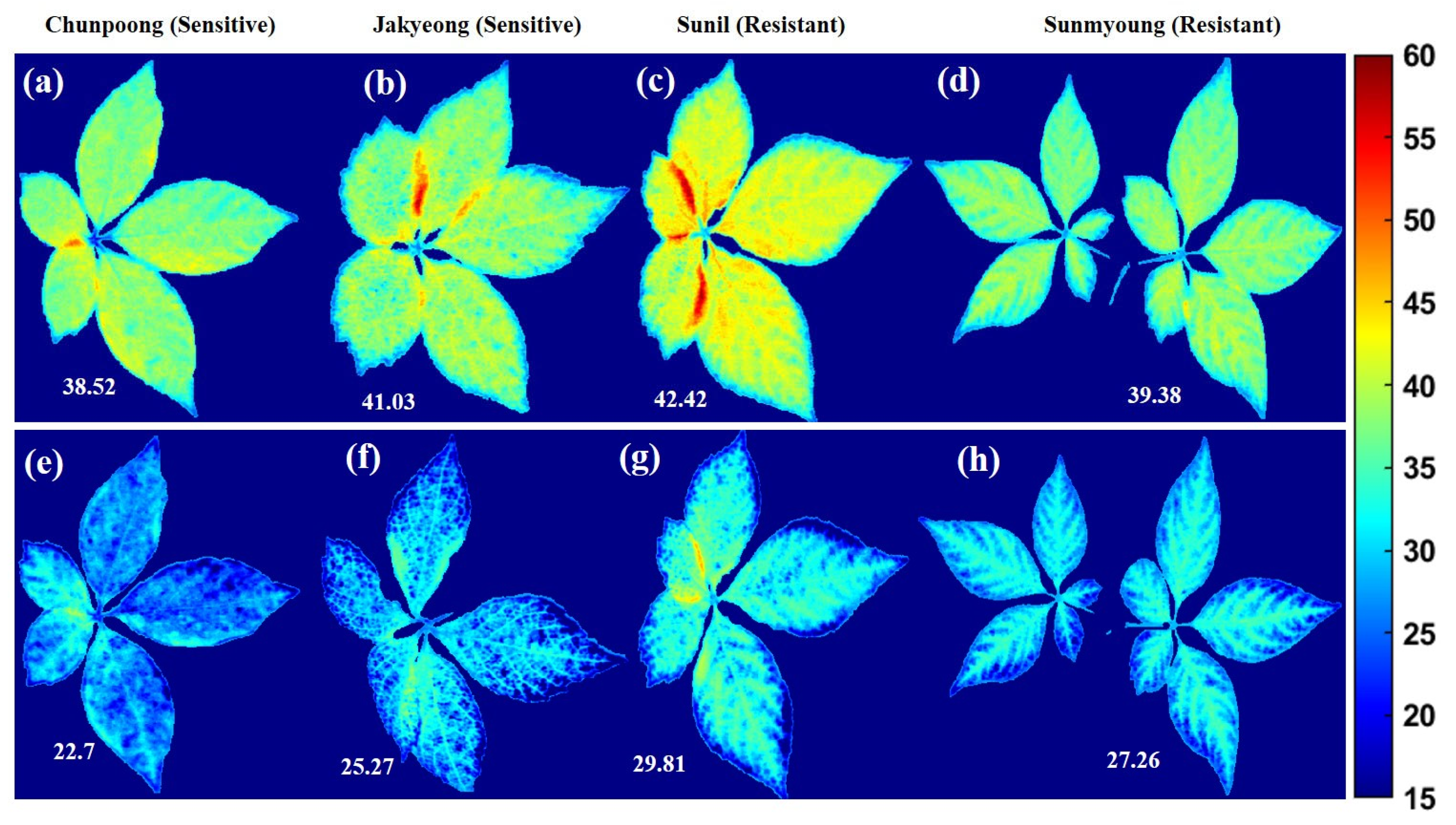
| Total Plants | Ratio WB [nm] | TH | No. of Correctly Detected SP | Sensitivity [%] | No. of Correctly Detected CP | Specificity [%] | Accuracy [%] |
|---|---|---|---|---|---|---|---|
| 160 | 683/693 | 1.13 | 66/80 | 82.5 | 80/80 | 100 | 91.25 |
| 160 | 683/703 | 1.04 | 68/80 | 85 | 80/80 | 100 | 92.5 |
| 160 | 683/731 | 1.12 | 78/80 | 97.5 | 80/80 | 100 | 98.75 |
| 160 | 683/745 | 1.92 | 76/80 | 95 | 80/80 | 100 | 97.5 |
| 160 | 731/745 | 2.08 | 74/80 | 87.5 | 80/80 | 100 | 96.26 |
| Preprocessing Methods | Calibration and Validation Results | ||||
|---|---|---|---|---|---|
| R2calb | SEC (%) | R2Val | RMSEV (%) | LV | |
| Raw | 0.91 | 2.85 | 0.90 | 3.59 | 10 |
| Smoothing | 0.89 | 2.89 | 0.89 | 3.61 | 10 |
| Max normalization | 0.91 | 2.87 | 0.89 | 3.61 | 10 |
| Mean normalization | 0.90 | 2.96 | 0.89 | 3.77 | 10 |
| Range normalization | 0.91 | 2.87 | 0.89 | 3.61 | 10 |
| MSC | 0.91 | 2.87 | 0.89 | 3.65 | 10 |
| SNV | 0.91 | 2.87 | 0.89 | 3.65 | 10 |
| SG 1st derivatives | 0.89 | 3.30 | 0.89 | 3.74 | 10 |
| SG 2nd derivatives | 0.90 | 3.01 | 0.89 | 3.74 | 10 |
Disclaimer/Publisher’s Note: The statements, opinions and data contained in all publications are solely those of the individual author(s) and contributor(s) and not of MDPI and/or the editor(s). MDPI and/or the editor(s) disclaim responsibility for any injury to people or property resulting from any ideas, methods, instructions or products referred to in the content. |
© 2022 by the authors. Licensee MDPI, Basel, Switzerland. This article is an open access article distributed under the terms and conditions of the Creative Commons Attribution (CC BY) license (https://creativecommons.org/licenses/by/4.0/).
Share and Cite
Faqeerzada, M.A.; Park, E.; Kim, T.; Kim, M.S.; Baek, I.; Joshi, R.; Kim, J.; Cho, B.-K. Fluorescence Hyperspectral Imaging for Early Diagnosis of Heat-Stressed Ginseng Plants. Appl. Sci. 2023, 13, 31. https://doi.org/10.3390/app13010031
Faqeerzada MA, Park E, Kim T, Kim MS, Baek I, Joshi R, Kim J, Cho B-K. Fluorescence Hyperspectral Imaging for Early Diagnosis of Heat-Stressed Ginseng Plants. Applied Sciences. 2023; 13(1):31. https://doi.org/10.3390/app13010031
Chicago/Turabian StyleFaqeerzada, Mohammad Akbar, Eunsoo Park, Taehyun Kim, Moon Sung Kim, Insuck Baek, Rahul Joshi, Juntae Kim, and Byoung-Kwan Cho. 2023. "Fluorescence Hyperspectral Imaging for Early Diagnosis of Heat-Stressed Ginseng Plants" Applied Sciences 13, no. 1: 31. https://doi.org/10.3390/app13010031
APA StyleFaqeerzada, M. A., Park, E., Kim, T., Kim, M. S., Baek, I., Joshi, R., Kim, J., & Cho, B.-K. (2023). Fluorescence Hyperspectral Imaging for Early Diagnosis of Heat-Stressed Ginseng Plants. Applied Sciences, 13(1), 31. https://doi.org/10.3390/app13010031







